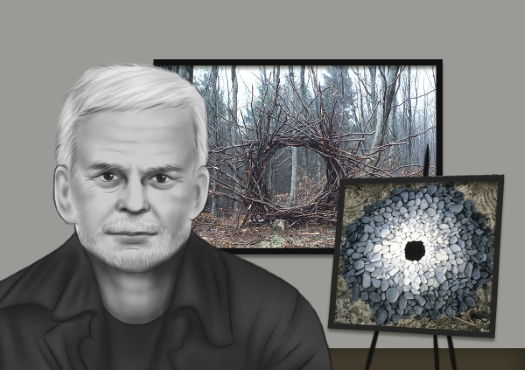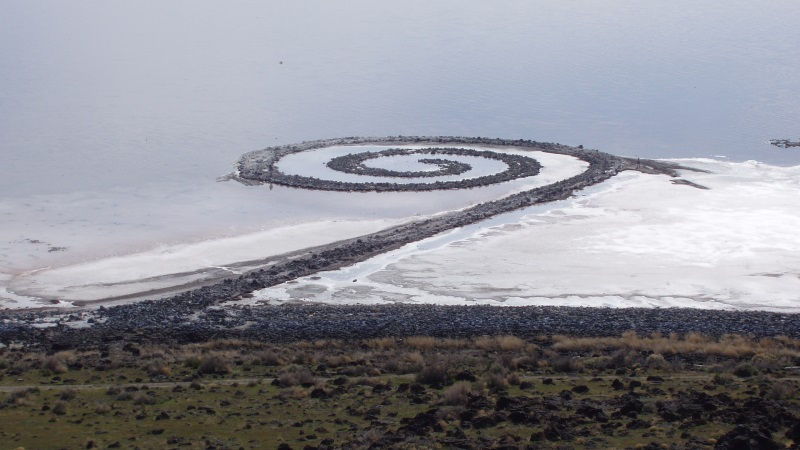Summary of Andy Goldsworthy
A sculptor and photographer, Andy Goldsworthy not only works with nature, but in nature. Rather than building monumental constructions on or out of the land, Goldsworthy works almost telepathically with nature, rearranging its natural forms in such a way as to enhance rather than detract from their beauty. Often quite small in scale, his poetic site-specific pieces are made from ephemeral or organic materials - dandelion flowers lain in a ring or icicles perched on a rock - and then documented through gorgeous color photographs. Goldsworthy views the inevitable death and decay in his work as part of the life cycle - he takes an environmentalist's approach, lending an utmost respect toward the natural world as most of his pieces gradually fade away into the land from which they've come.
Accomplishments
- The natural world (and all its myriad forms) is the artist's primary material. As a sculptor working with nature, Goldsworthy harnesses its limitations to gain a deeper understanding of it. His approach not only makes nature the co-author of his work, but emphasizes that human beings are not separate from nature, but are rather an inexorable part of it.
- Goldsworthy's work draws upon a Minimalist aesthetic that derives from seeing the poetic in the everyday. Stones, rocks, branches, twigs, leaves and ice are arranged carefully and patiently, making use of various repeated motifs such as snaking lines, spirals, circles and holes.
- Goldsworthy is a very hands-on sculptor for whom a large point of the work resides in the process of making it. "Learning and understanding through touch and making is a simple but deeply important reason for doing my work." His enthusiasm and wonder express themselves through the making, as he remarked, "each work is a discovery."
- The passage of time and its eventual dissolution of materiality is central to Goldsworthy's work. In focusing on ephemerality, Goldsworthy rejects the idea of art as a commodity to be exhibited and sold. Furthermore, he sees the fact that he uses temporal objects as a reflection of the ever-changing world we live in and the need to understand that nothing is eternal.
- Goldsworthy is interested in the social history of the land on which he is working and that includes its human population. He feels it is important to acknowledge a site's rich history and the various connections that people have in relationship with the land. As he has said, "People also leave presence in a place even when they are no longer there."
The Life of Andy Goldsworthy
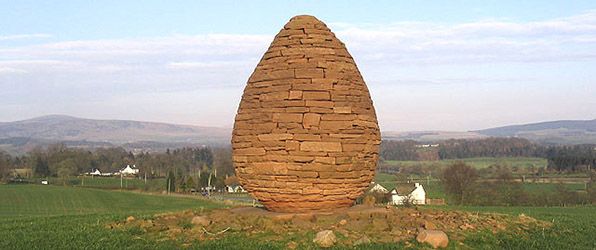
"My home... is the origin of many of my ideas and feelings towards the land," Andy Goldsworthy said. He built Millenium Cairn (2000) on a little hill outside his village because, because he said, it had "a sense of guarding the road."
Important Art by Andy Goldsworthy
Stones sinking in sand, Morecambe Bay, Lancashire
Stones sinking in sand, Morecambe Bay is one of Goldsworthy earliest works. Although made while he was still a student, works such as this were pivotal in shaping his overall direction. Here he uses small rocks found onsite to create a straight line into the water. The orderliness of this manmade line contrasts with the more organic forms created by nature. With the changing tides however, the line loses its shape and eventually vanishes. In Goldsworthy's own words:
This is a very physical piece. I had to move a lot of stones in one day, between the tides. It wasn't even a full day. The line of stones physically affected the place and the people who walked along the beach. People had to step over it. A horseback rider jumped over it. I revisited it several times and saw it sink into the sand and disappear. I often think of it still being there, although I know it isn't intact.
The significance of this work, perhaps more of a study than a finished piece, lies in the artist's acceptance of nature as the co-author of the piece. Goldsworthy sees human beings as part of nature rather than separate or distant from it, something he understands could suggest his work has a spiritual or mystical purpose. His overriding interest though is practical - he wants to investigate what he describes as the "energy of making" inside of things, while seeing the energy and space around a material (the effect of the weather for example) as being as important as the energy and space within. As he puts it himself, "movement, change, light, growth and decay are the lifeblood of nature, the energies that I try to tap through my work." Additionally, the ephemerality of the materials triggers a discussion regarding the role of the record in the artwork itself. As is often the case with Land art, the viewer is left wondering if the actual work is the short-lived sculpture or the photograph that documents it.
Rocks, sand, and sea water
Red Leaf Patch, Cumbria
Painterly compositions utilizing nature's organic colors and forms, such as Red Leaf Patch, are one of Goldsworthy's trademarks. To create this bright spot, Goldsworthy describes how he found "one dark and one light leaf of the same size. I tore the dark leaf in two, spat underneath it and pressed it on to the light leaf: the result was what appeared to be a single, two-colored leaf."
Red Leaf Patch is a slightly illusionistic, zinging composition in which the red circle appears to be on a different plane from the dark one underneath. In this way, Goldsworthy relates to the Bauhaus artist Joseph Albers whose studies underscored the power of color in creating space. Works such as Red Leaf Patch led some to criticize Goldsworthy for overly aestheticizing nature. In his own defense, he has argued: "But I have to work with flowers and leaves, because they are part of the land."
Time passing is the main attribute of Red Leaf Patch. Firstly, the work is ephemeral, eventually vanishing in nature. Goldsworthy is specially interested in the concept of decay - it appears time and again in his works and in his writings. The leaves are only red for a season. They will inexorably turn black and rot, ultimately resulting in re-absorption into the soil. As Goldsworthy has stated, his art has made him aware of "how nature is in a state of change and how that change is the key to understanding. I want my art to be sensitive and alert to changes in material, season and weather." This is a point reinforced by the scholar Jeffrey L. Kosky in his assertion that "what is interesting is that for Goldsworthy nature does not specify the place of things but their movement, not their being but their being in time."
Red Leaves (color photography, fujichrome)
Hole, Serpentine Gallery
Goldsworthy's Hole, made inside the Serpentine Gallery in London, is a continuation of a commission from 1981, in which he created another hole in the gallery's garden. This later Hole, unusual for Goldsworthy, takes a work of nature out of its solely pastoral setting, and brings it into the gallery setting - in a decidedly Robert Smithson fashion.
Artists have often used black holes to signify death, and specifically associations between death and art institutions are not uncommon. The perception of exhibition spaces as voids was part of an institutional critique trend that first inspired the generation before Goldsworthy to work outside. Regardless, whether inside or outdoors, the black hole has been a constant theme throughout Goldsworthy's career. He sees black space as not merely the absence of light but rather a positive presence, a tangible substance in its own right.
Goldsworthy has described how his concept of stability is brought into question when looking into a deep, dark hole. He describes how this encounter with blackness has made him aware of the earth's potent energies. He has also suggested that his last work, the one done before he dies will potentially be a hole. In the artist's own words: "Looking into a black hole is like looking over a cliff's edge ... I've always been drawn to the black hole - I've been making them since 1976 and I keep on making them ... I can't stop making them, and I have the same urge to make holes as I do to look over a cliff edge."
For Goldsworthy, the black hole can be seen as the ultimate enveloper of life, the final force in his obsession with natural decay, something always lurking at the edge of human perception that, brought into the gallery, acts to conjure recognition of our universal, inevitable fate.
Dirt and debris dug from the site
Icicle Star - Scaur Water, Penpont, Dumfriesshire
Icicle Star is of impressive delicacy, which required a high level of dexterity and skill to create. In an attempt to avoid high temperatures and sunlight, the work was made during the early morning hours in the dark. Goldsworthy used his saliva and bare fingers to meticulously and patiently attach the icicles. Because of the unpredictability of nature and the importance of ideal conditions, it often took him many minutes of holding each piece of ice for them to glue to each other and the process proved extremely painful at times.
The hardship required of the artist in having to withstand harsh conditions to produce works such as these turns them into endurance pieces alongside their intended commentary on the relationship between human hands and the machinations of the creator - a common theme in Goldsworthy's work.
Goldsworthy's ice works showcase his resilience and patience. For each piece that he is able to photograph, many others collapse half way through. In his own words, "I have held ice to ice seemingly for ages waiting for it to freeze only to let go and see it drop off. I have enormous respect for the weather." Given that ice is such a tricky material these ice works are remarkable for their fragile elegance. As noted by the critic Jeffrey L. Kosky, "the beauty of Andy Goldsworthy's work reminds us, even so, what it might mean to count on our hands, to count on them to open a world in which things appear, brought forth by the delicate, fine touch of human hands."
Ice and saliva - Photograph at the UK Government Art Collection
Storm King Wall
Storm King Wall is arguably Goldsworthy's most ambitious work to date. In this piece, he subverted the English agricultural tradition of building stone walls to delineate territory. His wall embraces and protects the trees instead of denoting a human-claimed space in which they might otherwise be fated for clearing. Although unexpected, the accentuated curves in Storm King Wall are based on 'crinkle crackle' or wavy walls - a type of traditional British masonry work that originated in the 18th century. The artist rejects any symbolism relating the wall to a snake while admitting that swirly and curvilinear forms are often seen in his works. The Storm King Wall however, does get straighter by the end of the field, thus relating to the New York State Thruway that passes nearby.
Besides being a permanent work - a lesser-known side of Goldsworthy's practice - Storm King Wall can also be seen as political. As the art critic Kenneth Baker points out: "Being unable to discern on which side of the wall the tree stands has peculiar echoes for American viewers. They reverberate, for example, in refrain of an old labor anthem: Which side are you on?' Americans feel it a matter of civic duty to take sides (...) on any issue of social or moral import." The work also functions as a symbolic reminder of the history of the land, which is also the history of mankind, through the appropriation of ancient devices for land demarcation. Goldsworthy asks us to consider the ways in which we co-opt land to define our own boundaries even if its natural state is one of unfettered freedom and dispossession.
Fieldstone - Storm King Art Center Collection
Moonlit Path
Moonlit Path is a work of incomparable poetry and originality. To create the piece, Goldsworthy delineated a convoluted path with white chalk. The work, which was temporary and site-specific, was meant to be experienced at night during a full moon. The moon's blueish-white light reflected on the chalk creating a luminescent trail which guided visitors through a one hour walk through the woods of Petworth Park in Sussex.
For visitors used to the excessive use of artificial light at nighttime, the walk became a time of contemplation. With limited vision the other senses were intensified. The quietness of the woods allowed visitors to experience the crack of each twig, the sounds of all creatures, and the smells associated with a dark, damp forest. This heightened awareness brought visitors closer to their primal instincts, serving as a reminder that we are all also animals. Moonlit Path also functioned as a metaphor for life. While at times the path was clear and bright, at other moments it became dark and scary. In a review for The Daily Telegraph Richard Dorment notes that "inseparable from its beauty is its ephemeral nature; since it won't last forever, and most people will walk on it once, its value to us is connected with a sense of loss."
This is also a fine example of Goldsworthy's interventions with nature that allow for the environment to collude in his final work. The application of chalk, accentuated by the moon, reflects a signature application of using painterly techniques to illuminate pre-existing organic elements of the landscape.
White Chalk
Rain Shadow, Times Square
Rain Shadow, Times Square is one of the latest examples of Goldsworthy's series of body imprints. He started this series in the mid-1980s and it soon became an obsession. In order to capture this Rain Shadow, Goldsworthy positioned himself on the ground in Times Square before the rain began, remained lying there throughout a storm, and then took a photograph of the 'shadow' created by his body. When recounting the experience, the artist mentioned that though many passersby would be indifferent to such a peculiar scene, others would also lay down or jump over him. At a certain point, a police officer warned him about all the potential diseases he could get from spreading his body on the pavement of such a busy area.
While many of these Rain Shadows were made in rural environments, the urban setting of Times Square highlights the fact that human beings, even while ensconced in urbanity, still inherently coexist with nature. Instead of seeing both as opposites and exclusionary, Goldsworthy proposes an understanding of nature's unstoppable quality and of its affect on a manmade world. As noted by the curator Molly Donavan, "Goldworthy's varied exploration of body shadows has a broader reference: it addresses the relationship of man and nature as well as the opposition of figure and ground at the basis of our vision, suggesting that the dominant view of man as a figure against the background of nature needs correction." As an environmentalist, such issues are of upmost importance for Goldsworthy. Furthermore, although there is no direct relationship between him and the Cuban-American artist Ana Mendieta, the Rain Shadows series share a strong visual and conceptual similarity with her Siluetas done in the mid-1970s. This is an important example of Goldsworthy's work as it makes connections to a previous generation of artists who questioned the role of the white, sterile gallery space.
Digital photographic record; water and pavement
Biography of Andy Goldsworthy
Childhood
Andy Goldsworthy was born in the town of Sale in Cheshire in the north of England. While still a young child, he moved with his family to a suburb on the outskirts of Leeds. His parents, F. Allin and Muriel Goldsworthy, were strict Methodists, instilling a hard work ethic into the artist from an early age. At age 13, he began spending his weekends and summers working in nearby farms. Instead of being interested in heavy machinery like the majority of the farm workers, he preferred the meditative quality of repetitive manual tasks. Clearly some important ideas about the possibilities inherent in nature began to take shape at this time. As he remarked later: "Farming is a very sculptural profession. Building haystacks or ploughing fields, burning stubble." Additionally, Goldsworthy's father was a mathematics professor at the local university and although Andy did not share his particular talent, it is tempting to make a connection between this and the patterns and formations that he would come to find in nature.
Early Training and Work
Goldsworthy was certain that he would be a farmer or gardener, and that art would be a hobby. This lack of confidence was probably a result of the initial hurdles he came up against when applying to art schools. He applied to several before, in 1974, he was finally accepted as a foundation student at Bradford College of Art. Once he finished his foundation year, he again struggled to find a place on a degree course. His resilience ultimately paid off, and from 1975 to 1978 he studied art at Preston Polytechnic in Lancaster.
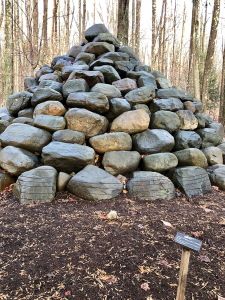
While in art school, Goldsworthy could not stand working in a minuscule partitioned studio. This led him to explore the great outdoors, a move that was pivotal for his work and ultimately shaped his entire career. In nature, he found inspiration and ample materials. In his own words: "One day in first year (of college) I went out to the beach and dug things, made lines, and the tide came in and washed it away. I learned more about the tide, the sand, the texture, I learnt so much in that couple of hours. And I shifted to working outside. I didn't really go back in again." Through his professors, he was introduced to and inspired by the works of Joseph Beuys and Robert Smithson. Although Goldsworthy's recognition grew steadily from this point on, the ephemeral nature of his work meant that he was an artist that was not easily categorized, remaining largely outside the gallery system and outside of the market. It also meant that of necessity he had to find ways of documenting his work so that there would be some tangible, physical evidence of his many fleeting natural creations. It took Goldsworthy almost a decade to start making enough money to file tax returns.
Mature Period
In 1982, Goldsworthy married the sculptor Judith Gregson. Not long after, she obtained a job in Carlisle and they moved north. A few years later, mainly for financial reasons, they crossed the border to the village of Penpont in the Scottish low lands, where he still lives today. Together, they had four children: James, Holly, Anna, and Thomas.
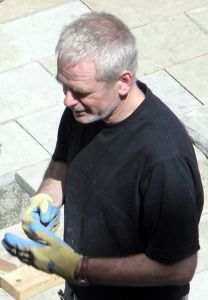
By the mid-1990s, Goldsworthy was a renowned artist. He had public and private commissions all over the world, yet art critics and historians sometimes criticized his work for solely beautifying nature. At a time when conceptual artists were dominating the landscape, some saw his work as not being conceptual enough and that his pastoral approach to art making could be deemed as overly pretty. Goldsworthy himself remained resolute, reflecting on the transient side of his creations and how "each work grows, stays, decays." In the early 2000s, he was appointed as a visiting professor at Cornell University in upstate New York; a position that he held for almost a decade. He also got the Order of the British Empire (OBE) - a reward given by the commonwealth for his contribution in the arts. Around the same time, and only a couple of years after the documentary River and Tides showed them as a happy and harmonious family, Gregson and Goldsworthy divorced.
Late Period
Soon after his divorce, Goldsworthy met the art historian Tina Fiske while she was participating in a project about his work. They became romantically involved and had a son named Joel. They are still together, although they have never married.
The following years were marked by great professional success and personal tragedy. In 2008, Goldsworthy's former wife died in a car accident. A few years later, his mother Muriel died unexpectedly (his father had already passed away). These losses influenced his later works, in which he built on ideas of transience, the void, and even straightforwardly, death. As he got older, his works became more somber and also more physical. Photographs depicting figures leaning into strong winds are amongst his most recent pieces. He currently works with his daughter Holly, who is helping to preserve his artistic legacy by extensively cataloguing his work.
The Legacy of Andy Goldsworthy
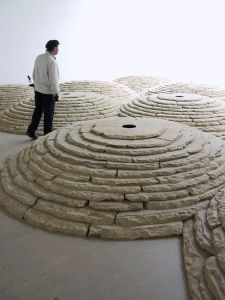
Goldsworthy reshaped Earth Art. Though other Land artists such as Robert Smithson (creator of the large-scale Spiral Jetty), Michael Heizer (creator of Double Negative), and the British artist Richard Long have all worked on large-scale landscape projects, Goldsworthy has developed a more intimate, sociological, and humanistic approach. His interest in specific geographical points of land, its history, and the relationship between organic material and the human presence has set him apart from those working with land as mere canvas or material.
In a piece for artnet, the critic Amah-Rose Abrams stated "unlike the monumental nature of some land art, Goldsworthy's art is about a subtle, often modestly scaled interaction with the outdoors. The elusiveness of beauty is key to his work, His art also bears a similarity to the work of Japanese architect Tadao Ando in its seamless relationship to the landscape." American artists Maya Lin and Michael Grab's work shares similarities with Goldsworthy's. Lin's The Wave Field and Goldsworthy's Storm King Wall are closely located inside Storm King Art Center - highlighting the dialogue between the two works. Grab's work balances pebbles in the same way Goldsworthy balances pieces of ice, twigs, and rocks.
Although it is difficult to pinpoint the extent of the artistic contribution of someone still very engaged in his career, Goldsworthy has made a very direct contribution to the environmental debate. His love and appreciation of nature has inspired many artists whose practice focuses directly on ecology. Artists such as Mel Chin, Ellie Irons, Mary Mattingly, and even the celebrated Gabriel Orozco and Vik Muniz, are amongst those that have used their art to stress the negative effects of modern society in the environment, and to propose a change. With the continuous pollution of the planet and global warming, such voices carry an important message.
Influences and Connections

-
![Richard Long]() Richard Long
Richard Long - Chris Drury
-
![Maya Lin]() Maya Lin
Maya Lin - Michal Grab
- Patrick Dougherty
- Dietmar Voorwold
Useful Resources on Andy Goldsworthy
- Andy Goldsworthy: ProjectsOur PickBy Andy Goldsworthy
- The Andy Goldsworthy ProjectBy Molly Donovan and Tina Fiske
- Hand to EarthBy Andy Goldsworthy and Terry Friedman
- The Art of Andy GoldsworthyBy William Malpas
- Midsummer Snow BallsBy Andy Goldsworthy
- Andy Goldsworthy: Ephemeral Works 2004-2014Our PickBy Andy Goldsworthy
 Ask The Art Story AI
Ask The Art Story AI